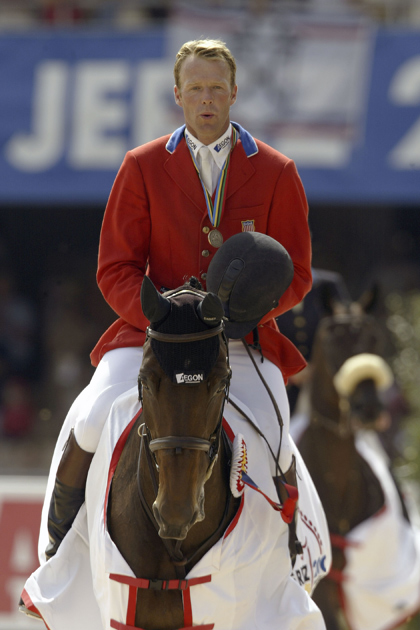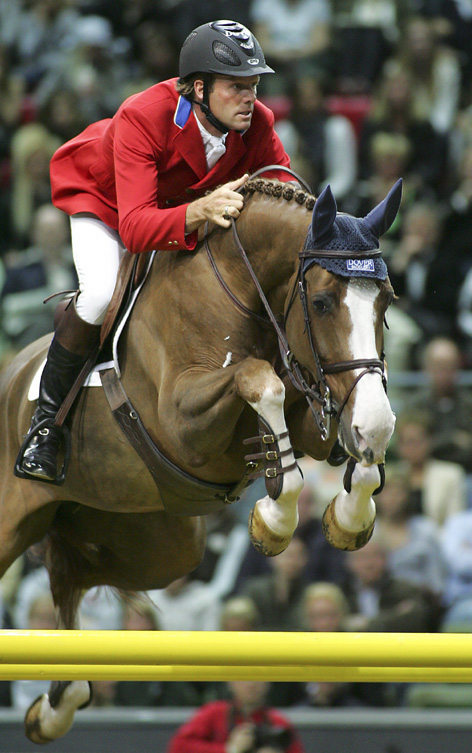
What makes an outstanding Equitation horse? ProEquest caught up with Peter Wylde to gain insight.
Blog
What makes an outstanding Equitation horse? ProEquest caught up with Peter Wylde to gain insight.
What is it that makes a great Grand Prix horse? A top speed horse or the perfect equitation horse? We know who they are, but how did horses like Fein Cera, Hello Sanctos, La Belle, Monterrey or Quax end up being Champions? To answer these questions, ProEquest caught up with Peter Wylde to see what he’s been up to these days and to gain insights into what made those horses remarkable and how they got to the top. In this first of a three part series, Peter Wylde talked to us about his current plans and projects. We also discussed some of his special horses over the years and what made them each uniquely suited for their jobs. Beginning with ponies at his home in Medfield, Massachusetts, Peter Wylde continued his successes, winning the ASPCA Maclay National Equitation Championship as a junior in 1982 and going all the way to the top representing the United States at the Pan American Games, the Olympics and the World Equestrian Games. Along the way, he found, developed and competed some of the greats in all three rings.

Peter Wylde and Jerez. PC - Chronicle of the Horse
Today, Peter is focusing on teaching. His association with the Emerging Athlete Program, now in its 11th year, has been an important part of his career. He plans to cut down his client business, stating “I’m going to teach a little bit and ride a little bit because I love to do that, but I’m also going to really start to focus on giving clinics”. An important part of this is his involvement with the Emerging Athletes Program (EAP). This program is very special to Peter, “I’m going to do for the 10th time the Emerging Athletes final this year… It’s going to be a priority.” In fact, he mentioned that “this is the 11th year the EAP has existed and I’ll have done 10 of the finals. I did the very first one and did 9 in a row”. Overall, Peter feels that “the high level, top level grand prix jumping, I think I’ve done that enough. I really like to teach and I really like to teach the emerging athlete clinics for aspiring young kids who want to get into the Industry. It’s just fun for me to work with kids like that.”
You will still find Peter in the warm-up and in the show ring though. He will be in Florida this winter with Lauren Hough, who now has three of his horses, and he be showing a very nice hunter himself. He also plans on continuing to develop horses. “I plan on developing one or two young horses because I really like to ride.” Overall, he is looking to have a good balance with riding, training and teaching.

Peter Wylde and Esplanade World Cup 2008 Goteborg. PC - Chronicle of the Horse
Looking back over Peter’s history and his plans moving forward, it seems that there is no one better to talk about finding and making up Equitation, Speed and Grand Prix horses. When it comes to understand what makes an outstanding Equitation horse, Peter notes that “as equitation has gotten more and more, and these horses are better and better, a really good equitation horse is almost a really good anything…it could be a really good hunter or a really good grand prix horse, it’s really everything.” For more specifics, he states that “number one it has to be beautiful to ride, it has to have a big stride. Those two things are really important.” However, interior matters almost as much. “They have to be super brave, they can’t be spooky and chicken and in general you like them to be quiet.” He points out that “the really high ended equitation horses are beautiful movers and beautiful jumpers. The really good ones are fancy horses.” Today’s equitation horse is successful in multiple rings.
When asked for examples, Peter was quick to mention two top horses and riders. “Kelli Cruciotti’s horse Monterrey and Annabel Revers horse Quax, both got top results in hunter derbies. They were beautiful jumpers and could get top results in important hunter derbies.” He also pointed out that Quax was a success Grand Prix horse in Europe. Quax really epitomizes what Peter loves in an Equitation horse. “He’s a beautiful horse with a stunning gallop and he was (a) technique perfect jumper….such a beautiful jumper. It helps when the judges fall in love with the picture.” He has a similar view of Monterrey. “Monterrey is a beautiful jumper, and he’s got a huge stride. Both of those horses are really rideable. You can do one less in a line or you can do one more in a line seamlessly…..that’s what makes a great equitation horse.”
The development of an Equitation horse can have different paths. “Both Monterrey and Quax started their lives as jumpers.” Peter got lucky, as Quax had gotten older and his people wanted to sell him the price came down and they were able to purchase him as an equitation horse instead of a Grand Prix horse. On the other hand, professionals that are involved with equitation are now buying 5 and 6 year old prospects. “A really good equitation horse is a very, very valuable horse. Either because it gets leased every year for a high price or it gets sold….It’s hard to get your hands on really great ones.” It’s more and more common that “professionals are developing them from young ages. They may actually be Grand Prix jumpers but they don’t ever go that route because as a 6 year old they were spotted to be a top equitation horse.” This, Peter says, “is a sign of how big that sport has gotten.” “When I was a kid”, he says “oftentimes the best equitation horse was also doing the junior hunter division, they did both divisions.” He noted that “there was a horse called Dillon and he won in the hunter division and in the equitation division…that was Michael Sasso’s horse that he won the Maclay finals with.” “Nowadays, kids have 3 Equitation horses and 4 junior hunters; 2 smalls and 2 larges.” Overall, “there are so many more equitation horses in our country needed that (for) the industry to produce them as young horses is very important.”
As already mentioned Monterrey and Quax are among Peter’s all time favorite Equitation horses. Peter rode Quax in the 3’6 Performance Hunters before Annabel Revers did Equitation with him. What was really incredible is that he did his very first hunter class ever in Wellington and got a 2nd and a 3rd by the second day. This was a horse that had never done hunters or Equitation. “I always loved the horse.” He has had a tremendous record, winning many big classes with Annabel. “To fault him, he was a little bit small, he was 16 hands, maybe 16 and ½, not tall but he could have a huge stride and he was just so classy.”
Another incredibly wonderful equitation horse that Peter remembers was a 6 year old named Contigo that he found in Europe. Purchased as a Grand Prix prospect, this horse had an incredible rhythmical way of going. The client he purchased the horse for was going to University and needed one that was beautiful and very straightforward. After the owner stopped riding, the horse ended up with Ben Maher who showed him as a 9 year old, winning a 1.50m Grand Prix in Wellington. Peter ended up buying this horse back from the clients for one of his students. “The one problem with the horse is that when it was hot, he was incredibly lazy!” This was a significant concern since the new rider was a petite woman. Peter ended up riding him in the Saturday Grand Prix at the Hampton Classic and felt that he could be an exceptional Equitation horse since “he went around the Grand Prix like it was an Equitation class.” Buying him for the THIRD time for Annabel Revers, as a 10 year old he ended up “winning the Medal and the Maclay, in the first two equitation classes he did in Wellington out of 40 some.” Contigo has gone on to be one of the greats in Equitation. “He wasn’t quite as good a mover as some, but he was a superb jumper and had the best expression. He would stare at the jump through the bridle…..and would just walk down lines so easily.”
Check back for the second installment of our interview with Peter Wylde where he tells us what he thinks makes a great speed horse and reminisces about some of his favorites.
